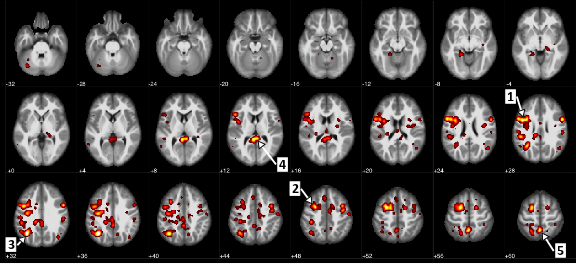Case Study
Diagnosing Schizophrenia
Amii researchers use machine learning to aid the diagnosis of mental disorders
Overview
Researchers from Amii, including Russ Greiner (Fellow, Amii; Professor, University of Alberta), are part of a team that works at the intersection of computing science and psychiatry in a field called computational psychiatry. This area uses computational tools – such as machine learning – to better understand psychiatric disorders through developing data-driven tools and methods to aid clinicians with diagnosis and symptom assessments.
About the Work
In a study published in Nature's partner journal, npj Schizophrenia, researchers demonstrated that machine learning algorithms can help predict instances of schizophrenia with 74% accuracy. This retrospective analysis also showed the technology predicted the severity of specific symptoms in schizophrenia patients with significant correlation, based on correlations between activity observed across different regions of the brain. This pioneering research could also help scientists identify more reliable objective neuroimaging biomarkers that could be used to predict schizophrenia and its severity.
In the paper, researchers analyzed de-identified brain functional Magnetic Resonance Imaging (fMRI) data from the open data set, Function Biomedical Informatics Research Network (fBIRN) for patients with schizophrenia and schizoaffective disorders, as well as a healthy control group. fMRI measures brain activity through blood flow changes in particular areas of the brain. Specifically, the fBIRN data set reflects research done on brain networks at different levels of resolution, from data gathered while study participants conducted a common auditory test. Examining scans from 95 participants, researchers used machine learning techniques to develop a model of schizophrenia that identifies the connections in the brain most associated with the illness.

Scans taken from participants, both from patients with schizophrenia and schizoaffective disorders, as well as a control group
Results
The results of the work demonstrated that, even on more challenging neuroimaging data collected from multiple sites (different machines, across different groups of subjects, etc.) the machine learning algorithm was able to discriminate between patients with schizophrenia and the control group with 74% accuracy using the correlations in activity across different areas of the brain.
Additionally, the research showed that functional network connectivity could also help determine the severity of several symptoms after they have manifested in the patient, including inattentiveness, bizarre behavior and formal thought disorder, as well as alogia, (poverty of speech) and lack of motivation. The prediction of symptom severity could lead to a more quantitative, measurement-based characterization of schizophrenia; viewing the disease on a spectrum, as opposed to a binary label of diagnosis or non-diagnosis. This objective, data-driven approach to severity analysis could eventually help clinicians identify treatment plans that are customized to the individual.
Future Directions
The Research Domain Criteria (RDoC) initiative of NIMH emphasizes the importance of objective measurements in psychiatry. This field, often referred to as “computational psychiatry”, aims to use modern technology and data-driven approaches to improve evidence-based medical decision making in psychiatry, a field that often relies upon subjective evaluation approaches.
As an extension of this work, researchers continue to investigate areas and connections in the brain that hold significant links to schizophrenia. Work will continue on improving the algorithms by conducting machine learning analysis on larger datasets, and by exploring ways to extend these techniques to other psychiatric disorders such as depression or post-traumatic stress disorder.
Acknowledgements
This work was jointly conducted by researchers from Amii, the University of Alberta, IBM Research, the University of Memphis and the University of Calgary. The paper "Learning stable and predictive network-based patterns of schizophrenia and its clinical symptoms" was co-authored by Mina Gheiratmand, Irina Rish, Guillermo A. Cecchi, Matthew R. G. Brown, Russell Greiner, Pablo I. Polosecki, Pouya Bashivan, Andrew J. Greenshaw, Rajamannar Ramasubbu and Serdar M. Dursun.
The researchers would like to thank the Function Biomedical Informatics Research Network (FBIRN) for sharing the schizophrenia fMRI dataset, supported by grants to the Function BIRN (NIH 1 U24-RR021992) Testbed. We would also like to thank WestGrid and Compute Canada for providing high-performance computing resources used in this research as well as the WestGrid support staff for their excellent technical support. This research was supported by IBM (Watson Research Center, U.S.) through IBM Alberta Centre for Advanced Studies (CAS), Canada, and Alberta Innovates Health Solutions (AIHS) through postdoctoral fellowships to MG, as well as NSERC grants to RG and internal funding from Amii.
Additional Links
- "Learning stable and predictive network-based patterns of schizophrenia and its clinical symptoms"
- "Machine learning enables new insight into schizophrenia"from the University of Alberta's Faculty of Science
- Computational Psychiatry Group at the University of Alberta
Latest Case Studies

Aug 31st 2020
Case Study
ANA: The Automated Nursing Agent
Researchers at Amii are developing ANA (Automated Nursing Agent), a conversational software agent (also known as a chatbot) designed to converse with elderly individuals who are living at home.

May 5th 2017
Case Study
DeepStack: Expert-level AI in Heads-up no-limit poker
DeepStack is the first AI to outplay human professionals at Heads-up No-limit Texas Hold'em poker and the first theoretically-sound application of heuristic search methods to imperfect information games.
